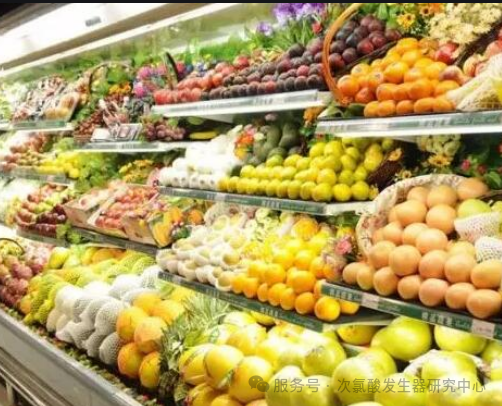
Pesticide residues are an important challenge to food safety. Traditional cleaning methods (such as water washing, salt water soaking, etc.) have limited effects on the removal of some fat-soluble or systemic pesticides. Hypochlorous acid (HOCL) is a broad spectrum, safe disinfectant, and its oxidizing property may effectively decompose organic phosphorus, organic chlorine and other pesticide molecules. In recent years, electrolytic hypochlorous acid generators have become a research hotspot in the field of fruit and vegetable cleaning because of their ready-to-use and controllable concentration characteristics.
The mechanism of action of hypochlorous acid in removing pesticide residues
1. Chemical oxidation reaction
Hypochlorous acid (HOCL) destroys the molecular structure of pesticides by releasing reactive oxygen species (ROS) and chlorination reaction
√ Organophosphorus pesticides (such as chlorpyrifos): HOCL oxidizes the P=S bond to a P=O bond, generating a low-toxic product
√ Pyrethroids: HOCl attacks the ester bond and decomposes into chlorohydrins and acids.
√ Carbamates: HOCl breaks the NH bond to form chloramine derivatives.
2. Advantages of hypochlorous acid
√ Permeability: With small molecular weight, it can penetrate into the wrinkles of the skin of fruits and vegetables.
√ Safety: The degradation products are water, chloride and trace CO₂, without secondary pollution.
√ Broad spectrum: Inactivates bacteria and viruses simultaneously, achieving the dual effects of "cleaning + disinfection".
Technical characteristics and application effects of hypochlorous acid generator
Advantages of hypochlorous acid
1. Hypochlorous acid concentration is adjustable, suitable for use in various scenarios
|
parameter |
Suitable range |
Influence |
|
Available chlorine concentration |
10-15 |
Too high a concentration may affect the taste of fruits and vegetables |
|
PH |
5.0-6.5 |
Maintain the molecular form of HOCL (converted to ClO⁻ when pH>7, the effect is reduced) |
|
Processing time |
3-10 minutes |
Depends on pesticide type |
2. Comparison of hypochlorous acid experimental data
|
Types of pesticides |
Conventional cleaning removal rate |
HOCL treatment removal rate |
|
Dichlorvos |
35% |
92% |
|
Chlorothalonil |
28% |
88% |
|
Cypermethrin |
40% |
85% |
3. Practical application cases
A commercial fruit and vegetable cleaning machine of a certain brand: using electrolytic HOCL technology (15PPM, PH6.0), after 5 minutes of treatment, the pesticide residue removal rate on the surface of strawberries was as high as 89%, and the total number of colonies was reduced by 99.7%.
4. Safety assessment of hypochlorous acid
√ Residual chlorine control: WHO recommends that residual chlorine after food contact should be less than 0.5 mg/kg, and rinsing with HOCl solution for 30 seconds can meet the standard.
√ Nutritional impact: Comparative experiments show that the loss of nutrients such as vitamin C and polyphenols is less than 5% when treated with HOCl below 50 ppm.
√ Equipment safety: Modern generators are often equipped with ORP sensors and automatic power-off functions to avoid overproduction.
Chlory Technology Co., Ltd. is a company that focuses on food, livestock deodorization, agriculture and other fields, with many mature cases. If you want to know more about hypochlorous acid generators, please call: +86 152 2277 1011 or email [email protected].
